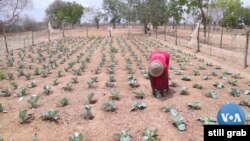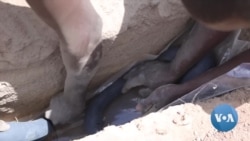More frequent and severe droughts in Africa are hampering food production, especially in arid parts of the continent, where farmers struggle to eke out a living. A water retention system developed in the United States is helping African farmers fight the trend and improve crop yields in drought-affected areas.
Under the scorching sun in the Ulilinzi village of southeastern Kenya, farmers are engaging in unique land preparations.
They are installing in the ground specially designed polyethylene membranes that look like clear covers, to prevent the loss of moisture and nutrients from the soil.
Exacerbated by drought from climate change, the sandy soil in this area, like in most arid and semi-arid areas, has made it nearly impossible to produce abundant crops.
However, this new water retention technology developed in the U.S. is giving farmers here new hope.
Alvin Smucker is a professor of soil biophysics at Michigan State University who developed the technology.
“We had a lot of government funding, going into millions and millions of dollars to put all these systems together. And then test it in Texas, Arizona, California and Michigan. And these … we … all four universities that worked with us. So, this is not something that we just put a little container in the backyard — my backyard — and now we are saying it is the best in the world. It has been tested,” he said.
Shem Kuyah, a researcher at the Jomo Kenyatta University of Agriculture and Technology, is one of the scientists leading the trials of the technology in Kenya.
“We have tested the technology with cowpea[s]. We have also tested the technology with maize, and we realized that farms where we had installed these membranes were more productive,” said Kuyah.
The technology has so far been tested in Zimbabwe and Kenya and is getting good reviews.
Florence Mutisya, a farmer in Ulilinzi village, has deployed the technology in her farm.
She said when the technology came, she was trained on how to make her sandy soil farm fertile. “I saw the benefits and deployed it in my farm. And I can say that this technology is working very well because now, I get [a] good harvest.”
A few meters away, Ann Mutunga is harvesting kales at her farm.
“This technology is very good.” She poses before she continues. “I can say it is good, because when it was used in my farm for trials, I harvested a lot of maize,” Mutunga explains. “Even now, we are very happy because as you can see, we have vegetables which you can’t find anywhere else around here,” she says, beaming with a smile.
The International Center for Tropical Agriculture is among the organizations spearheading trials of the subsurface water retention technology in the sub-Saharan region and says it can bring about a green revolution in the long run, as Sylvia Nyawira, a researcher at the center, explains.
“In addition to the technology, farmers, if they continue to apply, for instance, manure, retain their crop residues in the soil, reducing tillage in the soils. Then there’s buildup of organic matter. So, even in five years to come, the yields that we have been witnessing in plots that have the technology are expected to be much higher.”
Apart from improving crop yields, experts say the technology can also help in climate change mitigation through carbon sequestration.
“As you increase productivity, the crops are able to take carbon from the atmosphere and fix it into their biomass. And when this material is incorporated into the soil, it increases soil organic matter. And by increasing the organic matter in the soil, you are able to fix carbon dioxide that was once in the atmosphere. You are able to lock it into the soil,” said Kuyah.
A key drawback of this new water retention technology is the high cost and labor involved. It costs between 1,250 to 2,000 U.S. dollars to buy the specialized membranes to cover one hectare of land.
The challenge now is making this technology available for farmers in remote areas who need it the most.








